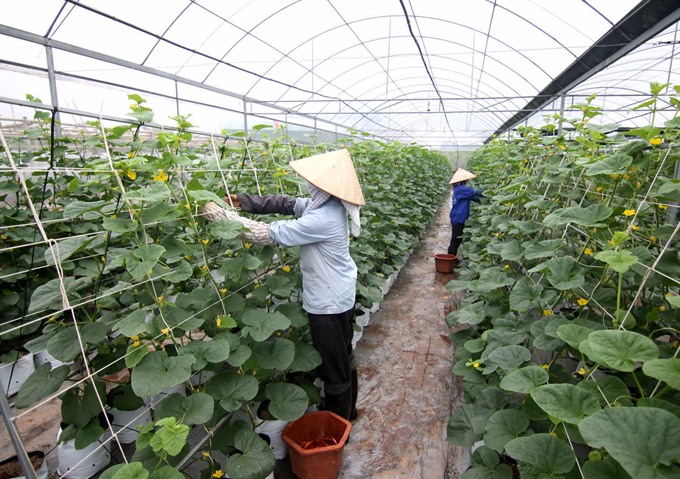 Politics & Law
Politics & Law

A thorough audit of all State-owned agricultural businesses will be carried out in 2019 following next year’s concentrated restructuring efforts, so as to identify underperforming firms and other issues facing the sector.
 |
| Hải Đăng farm in Mỹ Thắng Commune of Nam Định Province, with a total area of 12,000 sq.m. of greenhouse, is an example of hi-tech agriculture production in Nam Định Province, generating VNĐ200 million (US$8,800) in profits a year. — VNA/VNS Photo Vũ Sinh |
HÀ NỘI — A thorough audit of all State-owned agricultural businesses will be carried out in 2019 following next year’s concentrated restructuring efforts, so as to identify underperforming firms and other issues facing the sector.
The findings will be reported to the National Assembly, Deputy Prime Minister Vương Đình Huệ said at a conference last weekend.
The conference aimed to review the progress of restructuring, renewing, and improving the operational effectiveness of State-owned agribusinesses in the 2015-2017 period.
Hà Công Tuấn, deputy head of the Ministry of Agriculture and Rural Development (MARD), said that 40 out of 41 restructuring plans for the agriculture sector in cities, provinces, and enterprises had been approved by the Prime Minister.
Hà Nội’s agriculture restructuring plan was still being reviewed and adjusted by the municipal People’s Committee following feedback from the assessment council, he said.
Leaders of provinces including Lào Cai in the north, and Khánh Hoà and Bình Định on the south-central coast reported positive outcomes such as the streamlining of staff following new business plans directed by the Prime Minister.
More encouragingly, post-equitisation, previously 100 per cent state-owned companies have seen increased revenues and profits.
For example, annual revenues of the Bình Dương Province Rubber Co Ltd have jumped nearly three-fold post-equitisation, from VNĐ49 billion (US$2.16 million) to VNĐ133 billion ($5.86 million). Many forestry companies under the Việt Nam Forest Corporation (Vinafor) or the Việt Nam Rubber Group (VRG) also reported better earnings.
However, it was also pointed out the overall progress over the last three years in implementing Government’s 2014 Decree No. 118 on restructuring agro-forestry businesses had not been satisfactory.
For example, in HCM City, only 20 of 102 State-owned agriculture businesses have been equitised, and 28 companies that were supposed to be dissolved still remain operational.
Provincial agriculture officials mentioned many obstacles and challenges that they face.
Lò Minh Hùng, vice chairman of the northern mountainous province of Lào Cai, , said transforming SOEs into two-member limited liability companies was a totally new concept with many implementation bottlenecks.
“The ‘second member’ of the company is supposed to be a private entity, which poses very difficult questions about capital ownership, investment direction and land management. The land these companies are currently managing are really favourable to agriculture. When a private company comes into the picture, the repurposing of land could be a problem in our province,” he said.
Hùng urged the Steering Committee on Renovation and Development of Enterprises (under the Ministry of Finance) to issue guidance on implementing this particular company model to avoid losses and enable better management of capital and land resources.
Other provinces also reported that many farms and forestry units which have converted to totally State-owned companies or companies with majority State-ownership are facing difficulties in sourcing capital, delays in granting charter capital additions and lack of assets to use as collateral for bank loans.
A lot of companies undergoing restructuring are also struggling with issues like land measurement and mapping, brand valuation or resolving its bad debts, the conference heard.
For instance, the Việt Nam National Coffee Corporation is having trouble collecting VNĐ 380 billion ($16.76 billion) of outstanding debt from coffee-planting households as there’s no clear authority to handle this.
On the issue of land measurement and mapping related to all restructuring agricultural enterprises, which could end up costing VNĐ 1,100 billion ($48.44 million), Deputy Finance Minister Trần Văn Hiếu said the problem was not the cost, as the government will shoulder 70 per cent of it, but that local governments need to take stock of existing land through field trips, not just gathering figures from books.
Complex issues
Deputy Prime Minister Vương Đình Huệ said there were several reasons for the slow progress in restructuring.
Objectively speaking, this is a complex matter as it involves financial problems and land issues lasting decades, but the main cause remains a lack of commitment from some local governments, according to Huệ.
Other provinces that want to finish the restructuring quickly lack practical plans, eventually slowing the whole process because it takes time to adjust the plans.
Huệ stressed that the case of agricultural enterprises was different from the general restructuring effort because it involved the livelihoods of millions of people, with social order and security implications in many localities.
Underscoring that 2018 will be “the year of restructuring,” he directed that all restructuring plans must be completed and approved by the government in the final quarter of this year.
The Finance Ministry was tasked with issuing guidelines encouraging private businesses to join the two-member limited liability company model; and the Ministry of Environment and Natural Resources was asked to quickly update its land and forest database. — VNS




